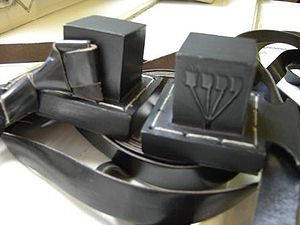Tefillin ,phylacteries, tefillin pictures, tefillin date, teffilin

Image via Wikipedia
Tefillin, also called phylacteries meaning "to guard, protect"), are a set of small cubic leather boxes painted black, containing scrolls of parchment inscribed with verses from the Bible, with leather straps dyed black on one side, and worn by observant Jewish men during weekday morning prayers. Although "tefillin" is technically the plural form (the singular being "tefillah"), it is loosely used as a singular as well. The hand-tefillin, or shel yad, is placed on the upper arm, and the strap wrapped around the arm, hand and fingers; while the head-tefillin, or shel rosh, is placed above the forehead, with the strap going around the head and over the shoulders. The Torah commands that they should be worn to serve as a "sign" and "remembrance" that God brought the children of Israel out of Egypt.
The source texts for tefillin in the Torah are obscure in literal meaning. For example, the following verse from the Shema states: "And you shall bind them as a sign upon your arm, and they shall be as totafot between your eyes."
The verse does not designate what specifically to “bind upon your arm,” and the definition of totafot is not obvious—the only other appearances of this word are in identical contexts (Ex.13:16 & Deut.11:18). But the authoritative oral tradition (Oral Torah) explains that it is these scriptural passages themselves (including the Shema) that are to be bound to the body in the form of tefillin. It is thus the Oral Torah that provides the details of the construction and application of tefillin.


0 comments:
Post a Comment